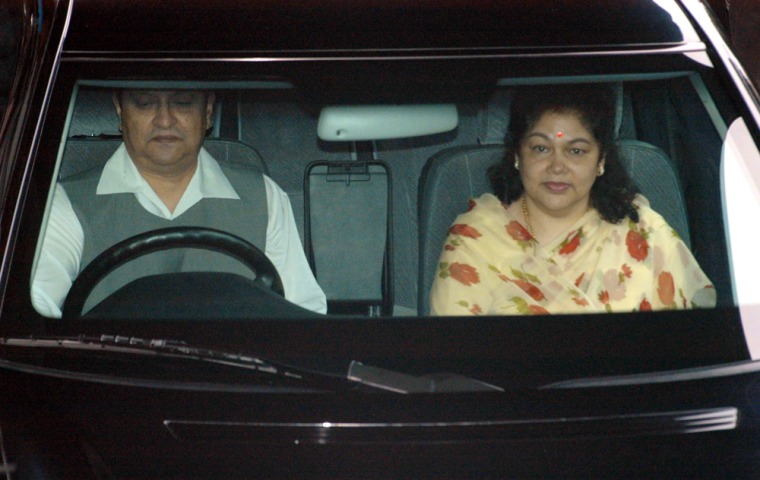It was a surprising sight in a land grown accustomed to surprises: the king at the wheel of a Mercedes-Benz, driving himself and his queen through the crowded streets of Katmandu.
"He was in the front seat! In traffic!" said Krishna Chetri, a 56-year-old shop owner.
"Where's the majesty?" he asked. "This is something I never would have believed."
In this Himalayan land, the Shah dynasty of kings reputed to be reincarnated Hindu gods is being pushed to possible extinction by the fallout from a decade-long communist rebellion and King Gyanendra's own autocratic ways.
Nepal votes Thursday for an assembly that will rewrite its constitution, the latest effort to transform a troubled, near-medieval land into a modern democracy.
And the assembly's first order of business: eliminating the monarchy.
"This king has done too much harm. He's shown us that we don't need kings," said Krishna Prashad Sitaula, a cabinet minister and a leader of the centrist Nepali Congress party who helped negotiate the peace deal with the rebels, known as the Maoists.
Not everyone is so sure.
"This king lost the people's favor," said Ram Shresthra Prasad, a 42-year-old priest at the Pashupatinath Temple, the clamorous shrine to which Gyanendra drove last month.
But "this talk of a secular republic is ignorant," he said. "Our kings created Nepal. They protect our Hindu religion. The kings are the symbol of Nepal."
End of the line?
Yet in many demonstrative ways, Gyanendra's 269-year-old Shah dynasty has reached the end of the line.
In January, Nepal's interim parliament formally declared the country a secular republic. Gyanendra's portrait has disappeared from shop walls and the currency. "Royal" has been removed from the name of the army and national airline. References to the king are gone from the national anthem.
Gyanendra has also endured other indignities. His $3.1 million annual allowance and 10 of the family's palaces were taken away, as were the queen's beauticians and about half his ceremonial guard.
Gyanendra can probably afford the losses. Before assuming the throne, he was known as a hardheaded businessman with interests in tourism, tea and tobacco.
He can also afford to hire his own driver, and did his own driving to show that he is at the people's disposal in what ever role it chooses, said a palace official who spoke anonymously because the government has told Gyanendra not to make public statements.
Split among the elite
Gyanendra's aides and supporters are hoping that the fractious political elite will be unable to agree on dumping him, and will also head public opinion, which seems far from unanimous about abolishing the monarchy.
A survey conducted in January by Interdisciplinary Analysts, a private firm in Katmandu, found 49 percent of Nepalis favored retaining the monarchy, and 12 percent undecided.
But Gyanendra, personally, fared far worse. The 3,000 people questioned gave him an average popularity rating of 2.8 on a scale of 1 to 8, the lowest of any major political figure. The poll gave a margin of error of two percentage points.
Gyanendra's dynasty dates to 1769, when a regional ruler conquered Katmandu and united Nepal.
The mystique of the royal line he founded was pierced in 2001 by a palace bloodbath in which a gunman, allegedly the crown prince, gunned down late King Birendra and much of the royal family before killing himself. Gyanendra, the dead king's older brother, then took the throne.
Four years later, with armed rebellion raging in the countryside, he dismissed an elected government and vowed to crush the Maoist rebellion himself.
He failed, and his popularity plummeted. By April 2006, widespread unrest had forced the king to restore democracy.
'He may live as common citizen'
Soon after, the Maoists ended their fight. And last year, in a deal that paved the way for Thursday's elections, they agreed with Nepal's major political parties that after the vote no man should wear the bejeweled Nepalese crown of yak hair and peacock feathers.
What happens to Gyanendra afterward is undecided. The leader of the Maoists, known by his nom de guerre, Prachanda, told The Associated Press that "he may live as a common citizen."
"But if he wants to resist the verdict of the masses," he said, "then I think he will be on trial and he will be punished."
So Gyanendra sits in his palace, a salmon-hued concrete 1970s monstrosity that dominates the capital's center, hoping time will work in his favor.
"I think we all believe, we hope, that they" — the politicians — "will not be able to agree," said Kamal Thapa, a cabinet minister under the king and now leader of the main royalist party.
"I know the king certainly believes that he will still be the king next year, and the year after," Thapa said. "Maybe he knows something we don't."
Critics, major politicians among them, say the king does know a few things, such as who is behind a handful of small bombings in the past year and protests in Nepal's southern Terai region that have already forced two delays in the vote. The palace denies the king is behind them.
Even the few die-hard royalists who are willing to speak up are beginning to wonder if a neutered monarchy is worth keeping.
"If the politicians are going to heap only abuse on our king, why should he stay?" asked Ravi Shrestra, a 38-year-old engineer. "What will happen next? Will they make him ride the bus?"
